Matthew Wiener, Co-Head of Transaction Services at AON, on trends in the energy and infrastructure space
In a recent ION Influencers Fireside Chat, Matthew Wiener, Co-Head of Transaction Services at Aon, talked about the evolving landscape of energy and infrastructure M&A transactions. The discussion revealed how insurance-backed solutions are reshaping deal-making, the shifting priorities of buyers and sellers, and the impact of global macro trends like AI growth and regulatory uncertainty.
How Client Needs Have Evolved
Over the past decade, M&A clients have moved from simply focusing on valuations to proactively managing risk. Sellers want to close quickly, return capital to investors, and avoid post-closing liabilities. Buyers, meanwhile, expect protection against undisclosed risks that could derail profitability. Aon steps in by transferring those risks — from tax and compliance issues to asset conditions — to insurance markets, ensuring smoother transactions on both sides.
Energy and Infrastructure: Unique Risk Profiles
While some risks are universal (such as financial misstatements, legal compliance, and tax exposure), the energy sector comes with distinct challenges. Wiener noted that asset condition is often the most material issue, with buyers facing heavy losses if refineries or pipelines require unexpected capital repairs. Environmental liabilities and real estate complexities (like rights-of-way and easements) also frequently surface, making specialized risk coverage critical.
Insurance as a Value-Creation Tool
What once was seen as an extra “workstream” in transactions has now become a value driver. By engaging Aon’s team early — ideally two to four weeks before signing — clients can identify risks, place insurance policies, and avoid eleventh-hour deal disruptions. Insurance solutions have expanded beyond unknown risks to also cover known issues, such as gaps in pipeline titles or ongoing litigation. This flexibility enables deals that might otherwise collapse.
Market and Regulatory Trends
Wiener highlighted two powerful forces shaping today’s deals:
-
Tariff uncertainty has disrupted valuations and slowed some M&A activity. Aon has responded with innovative solutions to protect transactions from potential tariff-related losses.
-
Artificial Intelligence and data centers are fueling demand for energy infrastructure. The need for more power and more efficient data transport is driving acquisitions of oil, gas, and midstream assets, alongside new renewable energy investments.
On the regulatory front, shifts in U.S. administrations have changed the tone of antitrust and sector-specific oversight. While regulation creates uncertainty, it also creates opportunities for insurers to step in and absorb that risk, offering buyers and sellers peace of mind.
Looking Ahead
Aon processes over 1,500 transactions globally each year, giving it a unique vantage point to identify emerging risks and trends. Wiener expects that the scope of what can be insured will continue to broaden, especially as AI and renewable infrastructure investments accelerate. His team is also evolving, hiring professionals with legal, investment banking, and sector-specific expertise to meet the growing complexity of client needs.
In five to ten years, Wiener predicts that transaction risk insurance will cover an even wider range of liabilities, from regulatory changes to tax credit validity in renewable projects — ensuring that deals move forward with greater certainty and speed
Key timestamps:
00:07 Introduction to the Fireside Chats
01:55 Evolution of Client Needs in Transactions
03:00 Assessing Risks and Liabilities in Transactions
04:40 Common Issues Across Sectors
07:06 Engaging Clients Early in Transactions
11:36 Trends in Client Demands and Solutions
14:53 Regulatory Changes and Their Impact
16:23 Current Market Trends and Future Outlook
18:31 Data Insights from Transactions
19:25 Team Composition and Hiring Trends
21:13 Future of Transaction Services Roles
22:49 Commoditization in Professional Services
24:05 Conclusion and Closing Remarks










